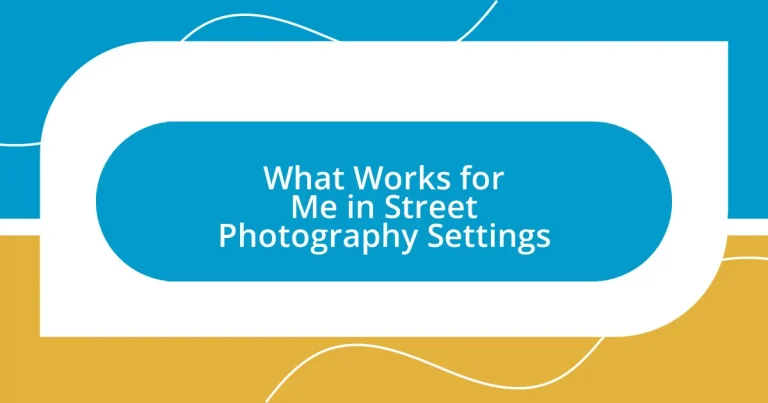Key takeaways:
- Mastering camera settings, such as using Aperture Priority and appropriate shutter speed, is crucial for capturing dynamic street photography effectively.
- Choosing lightweight, versatile gear allows for better mobility and spontaneity in urban environments, enhancing the ability to capture candid moments.
- Engaging with subjects and employing creative framing techniques can transform ordinary scenes into compelling stories that resonate on a deeper level.
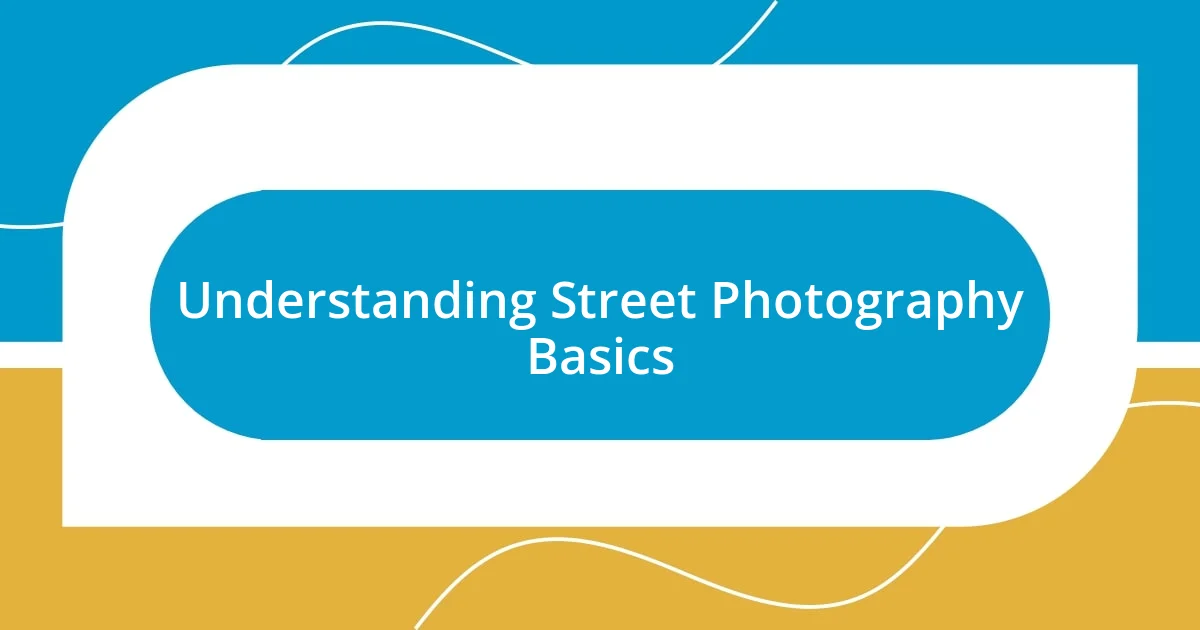
Understanding Street Photography Basics
Street photography is about capturing life as it unfolds in public spaces, often revealing the beauty in the everyday. I still remember my first solo outing, nervously snapping shots of strangers bustling about. I felt both exhilarated and vulnerable—would they notice me? Or worse, would they mind? That initial fear transformed into a sense of connection as I realized I was documenting shared human experiences.
Understanding the basics also means mastering your camera settings to adapt quickly to changing lighting and movement. I’ve found that using a wider aperture lets in more light and beautifully blurs backgrounds, which draws attention to the subject. Have you ever tried setting your shutter speed to freeze action? It might surprise you how a simple tweak can dramatically change your shot.
Another essential aspect is to be observant and patient. I once waited for what felt like eternity to capture a moment where a child and a street musician connected over a shared melody. That split second was magic—an exchange of joy that told a story far beyond what I could have imagined. So, ponder this: What stories are unfolding around you right now, waiting for you to capture them?
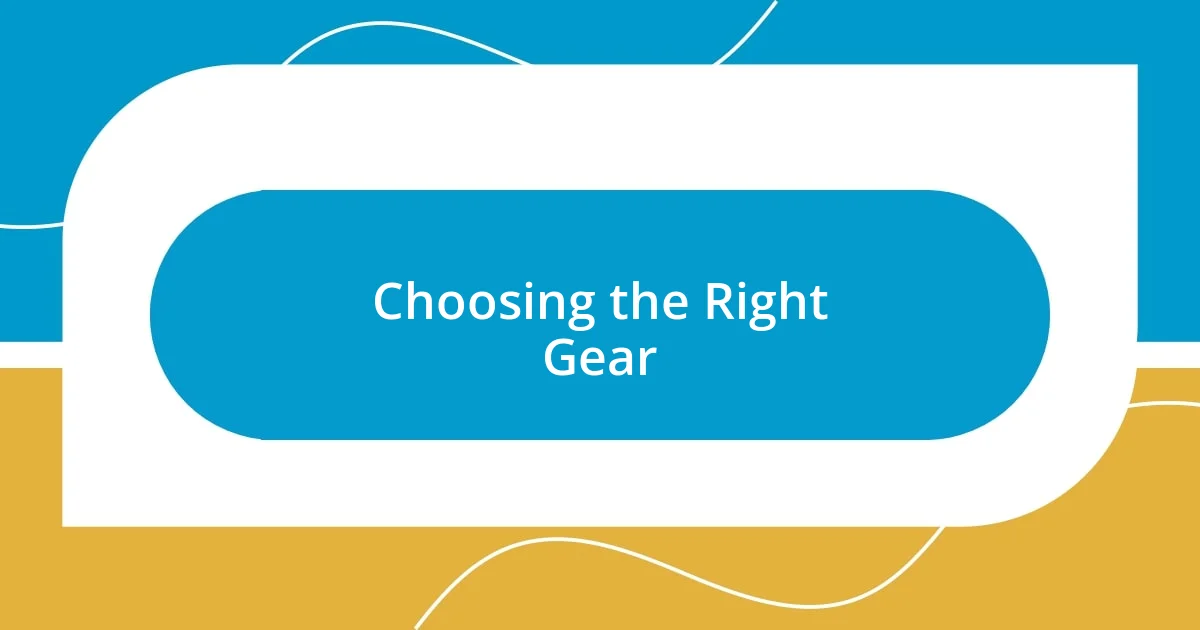
Choosing the Right Gear
Choosing the right gear can significantly impact the quality of your street photography. I’ve learned that my gear needs to be light enough for quick movements while remaining robust enough to withstand the unpredictability of the urban environment. Once, I lugged around a heavy camera and lens, which made me feel like a clumsy outsider rather than a part of the bustling scene. Now, I favor a mirrorless setup that allows me to blend in while capturing spontaneous moments without feeling weighed down.
When you’re out there, consider these essential gear elements:
- Camera Body: Opt for a compact and lightweight mirrorless camera for agility.
- Lens Type: A prime lens, typically 35mm or 50mm, gives you great image quality and versatility.
- Accessories: A neck strap or wrist strap for comfort, and perhaps a small backpack to carry extra memory cards and batteries.
- Settings: Always have your auto-focus set to continuous; you never know when the perfect shot will come along!
With the right gear, I find I can focus on the people and the stories around me, rather than getting lost in the technical aspects. It’s about creating a seamless experience that allows me to truly immerse myself in the scene.
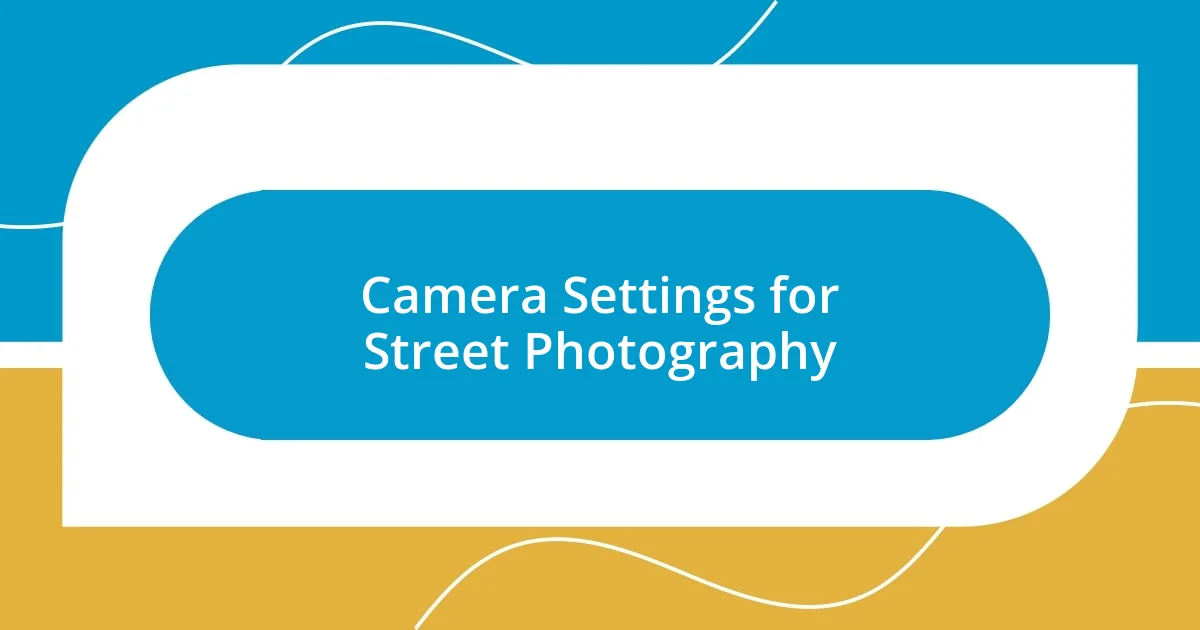
Camera Settings for Street Photography
When it comes to camera settings for street photography, I’ve discovered a few golden rules that work wonders. For instance, I typically set my camera to Aperture Priority mode, which allows me to control the aperture while the camera handles the shutter speed. This has saved me countless times; I remember one afternoon where the sun dipped behind clouds, and I was able to adapt quickly without missing a moment. The ability to blur the background with a wide aperture while ensuring my subject stays sharp can lead to stunning results.
Next, ISO is crucial in street photography. I tend to keep my ISO as low as possible to avoid noise, especially during bright daylight. However, I won’t hesitate to ramp it up in lower light conditions. Once, while shooting a vibrant street vendor at dusk, I raised my ISO to capture the colorful ambiance, and the result was a rich, textured photograph that truly spoke to the mood of the moment. These small adjustments can have a massive impact on the final image.
Lastly, shutter speed helps in freezing movement. I usually aim for a shutter speed of at least 1/500s when photographing action. There was a time when I snapped a cyclist zooming past; my camera’s fast shutter speed allowed me to freeze that exhilarating moment perfectly, capturing the thrill of the urban hustle. Finding that sweet spot in settings can transform a mundane scene into a dynamic story waiting to be told.
| Camera Setting | Recommended Value |
|---|---|
| Aperture | f/2.8 – f/5.6 for depth of field |
| ISO | 100 – 800 (adjust for light) |
| Shutter Speed | 1/250s – 1/1000s (to capture movement) |
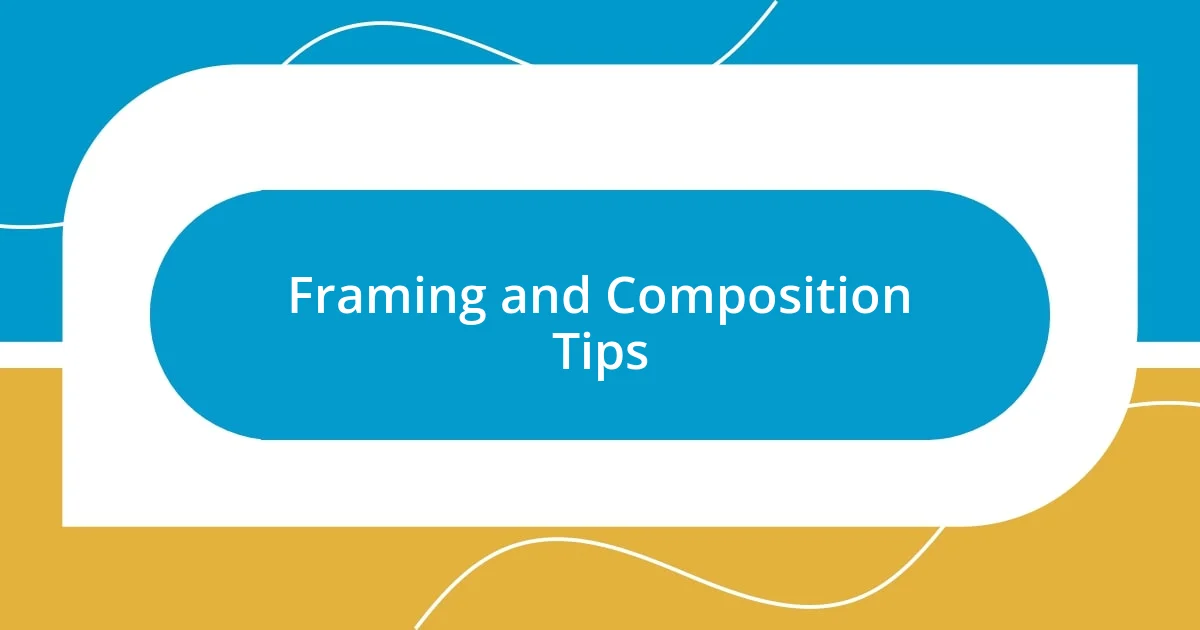
Framing and Composition Tips
Framing is vital in street photography—it’s like setting the stage for your story. I often use leading lines, such as roads or railings, to draw the viewer’s eye toward the subject. One day while wandering through a busy market, I noticed how the rows of stalls directed attention to a vendor passionately interacting with a customer. Capturing that scene framed by the vibrant shapes around them added depth to the story I wanted to tell.
When it comes to composition, I rely heavily on the rule of thirds. Dividing the frame into nine equal parts helps me position subjects in a way that feels balanced yet dynamic. I remember a moment when I was capturing a group of street performers; placing them off-center allowed the surrounding crowd to draw the viewer’s gaze around the image. Have you ever tried this technique? It might just give your photographs a sense of movement and life that a centered subject can sometimes lack.
Lastly, don’t be afraid to experiment with framing elements—doorways, windows, or even shadows can add layers to your images. On a particularly bright day, I found a shaded alcove that perfectly framed a couple engaged in conversation. The contrast between light and dark drew me in and made the shot pop. Each new framing opportunity can lead to unexpected narratives, urging us to look closer at the stories unfolding all around. So, what will you discover when you start exploring framing in your own street photography?
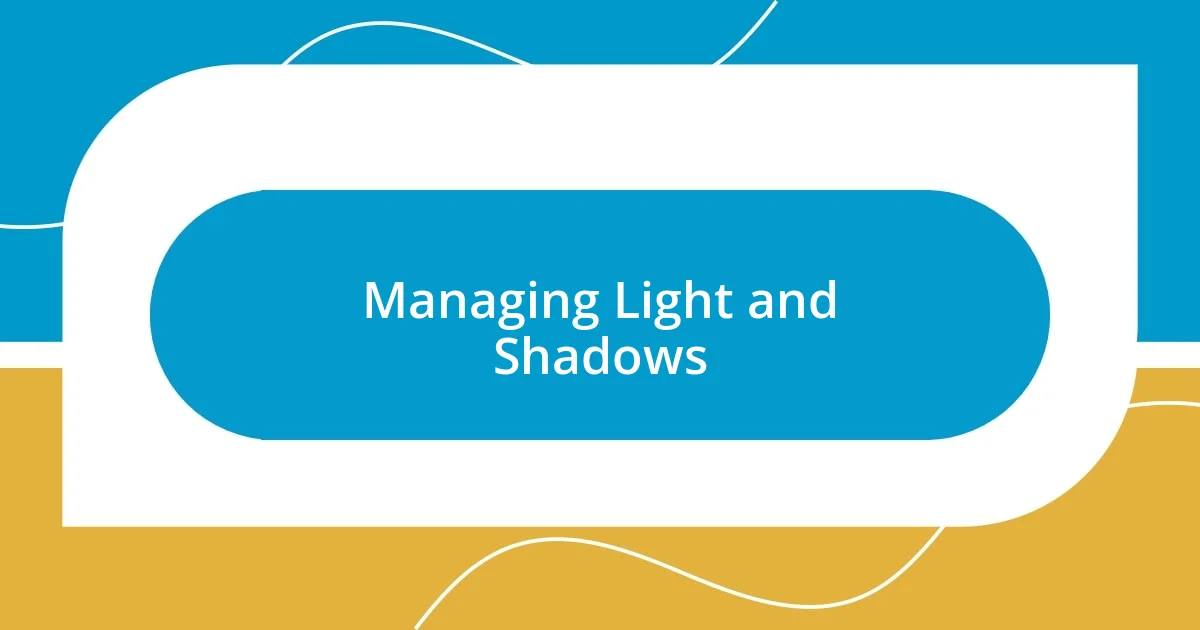
Managing Light and Shadows
Managing light and shadows can truly elevate street photography to a new level. I often find myself hunting for interesting contrasts, especially during the golden hour when the light casts a warm glow. One evening, while strolling through a quaint alley, I stumbled upon a shadowy figure walking toward a sunlit patch. The juxtaposition created a dramatic effect that made the image speak volumes about solitude in bustling urban life. Have you ever paused to notice how shadows can tell a story of their own?
Understanding how to manipulate light is essential for capturing emotions. In one memorable instance, I shot a street musician performing under a bridge, where harsh sunlight streamed through the gaps overhead. By positioning myself to play with the light hitting the musician’s face, I managed to encapsulate the fervor and passion in their performance. Those dappled highlights added layers to the shot, inviting viewers to delve deeper into the scene. Isn’t it fascinating how a little tweak in angle can breathe life into an image?
Paying attention to the time of day and how it influences shadows can also change the storytelling in your photographs. I often experiment with backlighting; once, capturing children playing with shadows cast by a setting sun led to some of my favorite images. Their laughter and movement contrasted beautifully against the elongated shadows. Have you explored the magic of backlighting? It can transform even the simplest moments into something enchanting and thought-provoking.

Engaging with Subjects
Engaging with subjects is a dance; it requires connection and a bit of intuition. I remember a time when I was capturing a local street fair, and I noticed a woman intently watching a puppet show with her child. Instead of just snapping a quick photo, I decided to lean in closer and sense their energy. As I got nearer, I felt the laughter and joy radiating from them, and my camera captured that bond beautifully. Have you ever felt the power of being present in a moment like that?
Creating a rapport with your subjects can lead to striking results. One particular encounter stands out; while photographing a group of elderly men chatting on a park bench, I smiled and asked if I could take their picture. They nodded, and I quickly engaged them in conversation, which revealed their rich stories and camaraderie. This little interaction transformed my photo session into something vibrant and meaningful, capturing not just their faces but the essence of friendship. Isn’t it amazing how a simple connection can elevate a photograph from a flat image to a soulful story?
Sometimes, just observing is enough to create a striking composition. During a recent stroll through a bustling city square, I noticed a street vendor who appeared immersed in his craft, completely unaware of the world around him. Instead of interrupting his flow, I quietly positioned myself nearby and let my camera tell his story. Capturing him framed by the vibrant market chaos around him felt like a secret glimpse into his life—a moment frozen in time. Have you ever just taken a step back, allowing the environment to deepen the subject’s narrative? It’s in those quiet observations that truly powerful images often emerge.
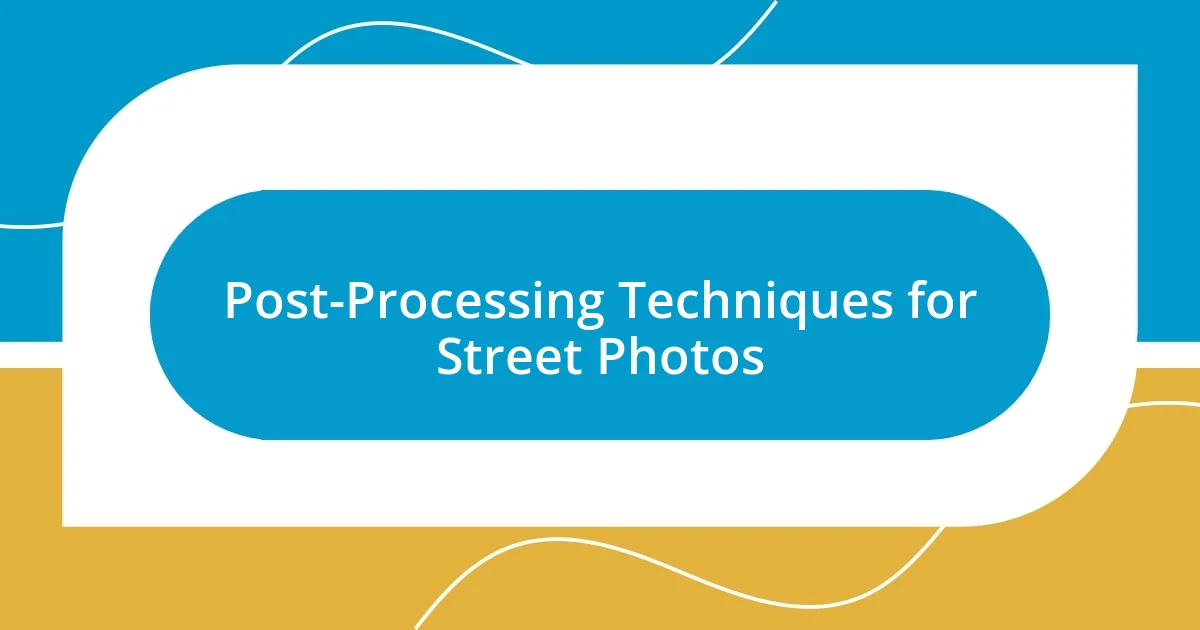
Post-Processing Techniques for Street Photos
Post-processing is where the real magic happens for street photos. I remember editing a shot of a busy market where the colors seemed to leap straight from the frame. By enhancing the saturation slightly and adding a touch of contrast, I was able to evoke the bustling energy I felt in that moment. It made me think: how often do we overlook the power of color correction in our storytelling?
One technique I often rely on is sharpening the details in my images. There was a particular photo of an elderly man selling flowers that stood out in my collection. By applying selective sharpening to his weathered hands and the delicate petals, I drew attention to his craftsmanship and endurance. This simple adjustment made the viewer feel more connected to his story. Have you considered how fine-tuning the sharpness can transform the emotional impact of an image?
Finally, don’t underestimate the impact of cropping. During a street festival, I shot a lively scene overflowing with movement and color. However, when I cropped it to focus on a group of dancers, the energy shifted. This tighter composition revealed not just their joy but also the intricate details of their costumes and expressions. It’s fascinating how a small adjustment can elevate a photo from an ordinary scene to an extraordinary moment. Have you ever experimented with cropping and discovered a new narrative within your own work?












